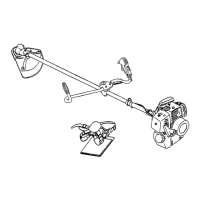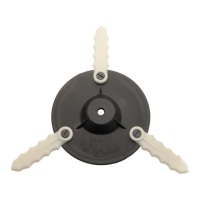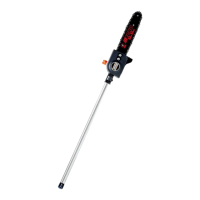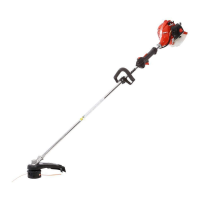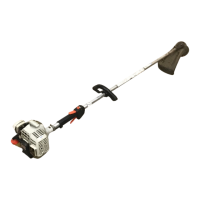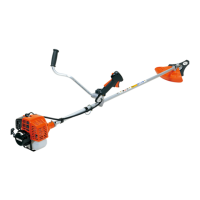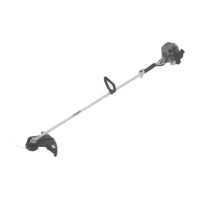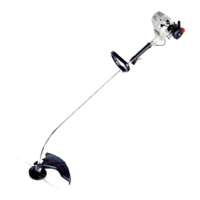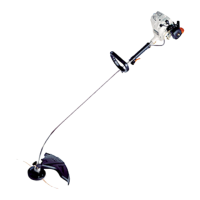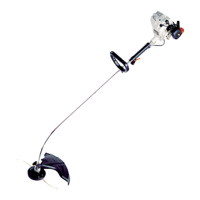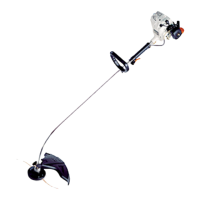34 English
source and/or battery pack, picking up or carrying
the tool. Carrying power tools with your finger on the
switch or energising power tools that have the switch
on invites accidents.
■ Remove any adjusting key or wrench before turning
the power tool on. A wrench or a key left attached to
a rotating part of the power tool may result in personal
injury.
■ Do not overreach. Keep proper footing and balance
at all times. This enables better control of the power in
unexpected situations.
■ Dress properly. Do not wear loose clothing or
jewellery. Keep your hair, clothing and gloves away
from moving parts. Loose clothes, jewellery or long
hair can be caught in moving parts.
■ If devices are provided for the connection of dust
extraction and collection facilities, ensure these are
connected and properly used. Use of dust collection
can reduce dust-related hazards.
POWER TOOL USE AND CARE
■ Do not force the power tool. Use the correct power
tool for your application. The correct power tool will
do the job better and safer at the rate for which it was
designed.
■ Do not use the power tool if the switch does not turn
it on and off. Any power tool that cannot be controlled
with switch is dangerous and must be repaired.
■ Disconnect the plug from the power source and/or
the battery pack from the power tool before making
any adjustments, changing accessories, or storing
power tools. Such preventive safety measures reduce
the risk of starting the power tool accidentally.
■ Store idle power tools out of the reach of children
and do not allow persons unfamiliar with the power
tool or these instructions to operate the power tool.
Power tools are dangerous in the hands of untrained
users.
■ Maintain power tools. Check for misalignment or
binding of moving parts, breakage of parts and
any other condition that may affect the power
tool’s operation. If damaged, have the power tool
repaired before use. Many accidents are caused by
poorly maintained power tools.
■ Keep cutting tools sharp and clean. Properly
maintained cutting tools with sharp cutting edges are
less likely to bind and are easier to control.
■ Use the power tool, accessories and tool bits etc.
in accordance with these instructions, taking into
account the working conditions and the work to
be performed. Use of the power tool for operations
different from those intended could result in a
hazardous situation.
BATTERY TOOL USE AND CARE
■ Recharge only with the charger specified by the
manufacturer. A charger that is suitable for one type
of battery pack may create a risk of fire when used with
another battery pack.
■ Use power tools only with specifically designated
battery packs. Use of any other battery packs may
create a risk of injury and fire.
■ When battery pack is not in use, keep it away from
other metal objects, like paper clips, coins, keys,
nails, screws or other small metal objects that can
make a connection from one terminal to another.
Shorting the battery terminals together may cause
burns or a fire.
■ Under abusive conditions, liquid may be ejected
from the battery; avoid contact. If contact
accidentally occurs, flush with water. If liquid
contacts eyes, additionally seek medical help.
Liquid ejected from the battery may cause irritation or
burns.
SERVICE
■ Have your power tool serviced by a qualified repair
person using only identical replacement parts. This
will ensure that safety of the power tool is maintained.
STRING TRIMMER SAFETY WARNINGS
■ Some regions have regulations that restrict the use of
the product. Check with your local authority for advice.
■ Never allow children or people unfamiliar with the
instructions to use the product.
■ Use the product in daylight or with good artificial light.
■ Avoid using on wet grass.
■ Do not walk backwards when using the product.
■ Keep firm footing and balance. Do not overreach.
Overreaching can result in loss of balance. Always be
sure of your footing on slopes. Walk, never run.
■ Avoid using the product in bad weather conditions
especially when there is a risk of lightning.
■ Keep bystanders, children, and pets 15 m away from
the area of operation. Stop the product if anyone enters
the area.
■ Keep the cutting attachment below waist level.
■ Do not use the product with damaged guards or without
guards in place.
■ Do not fit a metal replacement line.
■ Keep hands and feet away from the cutting means at all
times, especially when switching on the motor.
■ Beware, the cutting elements continue to rotate after
the motor is switched off.
■ Beware of objects thrown by the cutting means. Clear
debris like small stones, gravel, and other foreign
objects from the work area before starting operation.
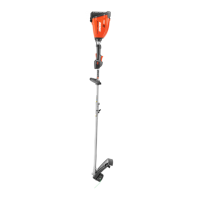
